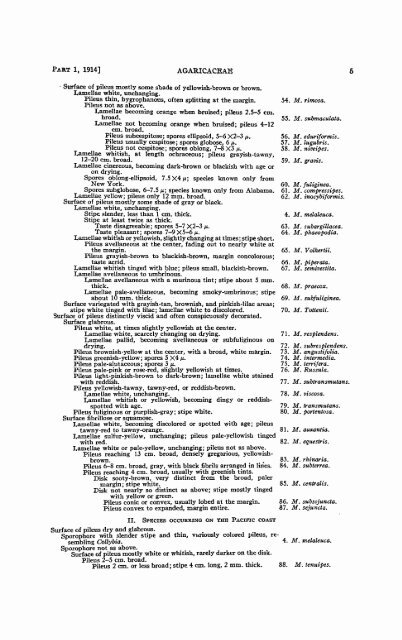North American Flora: Agaricales, Agaricaceae (Vol. 10 ... - MykoWeb
North American Flora: Agaricales, Agaricaceae (Vol. 10 ... - MykoWeb
North American Flora: Agaricales, Agaricaceae (Vol. 10 ... - MykoWeb
Create successful ePaper yourself
Turn your PDF publications into a flip-book with our unique Google optimized e-Paper software.
PART 1, 1914] AGARICACEAE<br />
• Surface of pileus mostly some shade of yellowish-brown or brown.<br />
Lamellae white, unchanging.<br />
Pileus thin, hygrophanous, often splitting at the margin.<br />
Pileus not as above.<br />
Lamellae becoming orange when bruised; pileus 2.5-5 cm.<br />
broad.<br />
Lamellae not becoming orange when bruised; pileus 4-12<br />
cm. broad.<br />
Pileus subcespitose; spores ellipsoid, 5-6 X2-3 p.<br />
Pileus usually cespitóse ; spores globose, 6 p.<br />
Pileus not cespitóse; spores oblong, 7-8 X3 p.<br />
Lamellae whitish, at length ochraceous; pileus grayish-tawny,<br />
12-20 cm. broad.<br />
Lamellae cinereous, becoming dark-brown or blackish with age or<br />
on drying.<br />
Spores oblong-ellipsoid, 7.5X4/*; species known only from<br />
New York.<br />
Spores subglobose, 6-7.5 p; species known only from Alabama.<br />
Lamellae yellow; pileus only 12 mm. broad.<br />
Surface of pileus mostly some shade of gray or black.<br />
Lamellae white, unchanging.<br />
Stipe slender, less than 1 cm. thick.<br />
Stipe at least twice as thick.<br />
Taste disagreeable; spores 5-7 X2•3 p.<br />
Taste pleasant; spores 7-9X5-6 p.<br />
Lamellae whitish or yellowish, slightly changing at times ; stipe short.<br />
Pileus avellaneous at the center, fading out to nearly white at<br />
the margin.<br />
Pileus grayish-brown to blackish-brown, margin concolorous;<br />
taste acrid.<br />
Lamellae whitish tinged with blue; pileus small, blackish-brown.<br />
Lamellae avellaneous to umbrinous.<br />
Lamellae avellaneous with a murinous tint; stipe about 5 mm.<br />
thick.<br />
Lamellae pale-avellaneous, becoming smoky-umbrinous; stipe<br />
about <strong>10</strong> mm. thick.<br />
Surface variegated with grayish-tan, brownish, and pinkish-lilac areas;<br />
stipe white tinged with lilac; lamellae white to discolored.<br />
Surface of pileus distinctly viscid and often conspicuously decorated.<br />
Surface glabrous.<br />
Pileus white, at times slightly yellowish at the center.<br />
Lamellae white, scarcely changing on drying.<br />
Lamellae pallid, becoming avellaneous or subfuliginous on<br />
drying.<br />
Pileus brownish-yellow at the center, with a broad, white margin.<br />
Pileus greenish-yellow ; spores 5 X4 p.<br />
Pileus pale-alutaceous; spores 3 p.<br />
Pileus pale-pink or rose-red, slightly yellowish at times.<br />
Pileus light-pinkish-brown to dark-brown; lamellae white stained<br />
with reddish.<br />
Pileus yellowish-tawny, tawny-red, or reddish-brown.<br />
Lamellae white, unchanging.<br />
Lamellae whitish or yellowish, becoming dingy or reddish-<br />
spotted with age.<br />
Pileus fuliginous or purplish-gray; stipe white.<br />
Surface ¿brillóse or squamose.<br />
Lamellae white, becoming discolored or spotted with age; pileus<br />
tawny-red to tawny-orange.<br />
Lamellae sulfur-yellow, unchanging; pileus pale-yellowish tinged<br />
with red.<br />
Lamellae white or pale-yellow, unchanging; pileus not as above.<br />
Pileus reaching 13 cm. broad, densely gregarious, yellowish-<br />
brown.<br />
Pileus 6-8 cm. broad, gray, with black fibrils arranged in lines.<br />
Pileus reaching 4 cm. broad, usually with greenish tints.<br />
Disk sooty-brown, very distinct from the broad, paler<br />
margin ; stipe white.<br />
Disk not nearly so distinct as above; stipe mostly tinged<br />
with yellow or green.<br />
Pileus conic or convex, usually lobed at the margin.<br />
Pileus convex to expanded, margin entire.<br />
II. SPECIES OCCURRING ON THE PACIFIC COAST<br />
54. M. rimosa.<br />
55. M. submaculata.<br />
56. M. eduriformis.<br />
57. M. lugubris.<br />
58. M. niveipes.<br />
59. M. gravis.<br />
60. M. fuliginea.<br />
61. M. compressipes.<br />
62. M. inocybíformis.<br />
4. M. melaleuca.<br />
63. M. subargiUacea.<br />
64. M. phaeopodia.<br />
65. M. <strong>Vol</strong>kertii.<br />
66. M. piperata.<br />
67. M. semivestita.<br />
68. M. praecox.<br />
69. M. subfuliginea.<br />
70. M. Tottenii.<br />
71. M. resplendens.<br />
72. M. subresplendens.<br />
73. M. angustifoUa.<br />
74. M. intermedia.<br />
75. M. terrifera.<br />
76. M. Russula.<br />
77. M. subtransmutans.<br />
78. M. viscosa.<br />
79. M. transmutans.<br />
80. M. portentosa.<br />
81. M. auxantia.<br />
82. M. equeslris.<br />
83. M. rhinaria.<br />
84. M. subterrea.<br />
85. M. centralis.<br />
86. M. subsejuncta.<br />
87. M. sejuncta.<br />
Surface of pileus dry and glabrous.<br />
Sporophore with slender stipe and thin, variously colored pileus, re-<br />
sembling Collybia. 4. M. melaleuca.<br />
Sporophore not as above.<br />
Surface of pileus mostly white or whitish, rarely darker on the disk.<br />
Pileus 2-5 cm. broad.<br />
Pileus 2 cm. or less broad; stipe 4 cm. long, 2 mm. thick. 88. M. tenmpes.
















